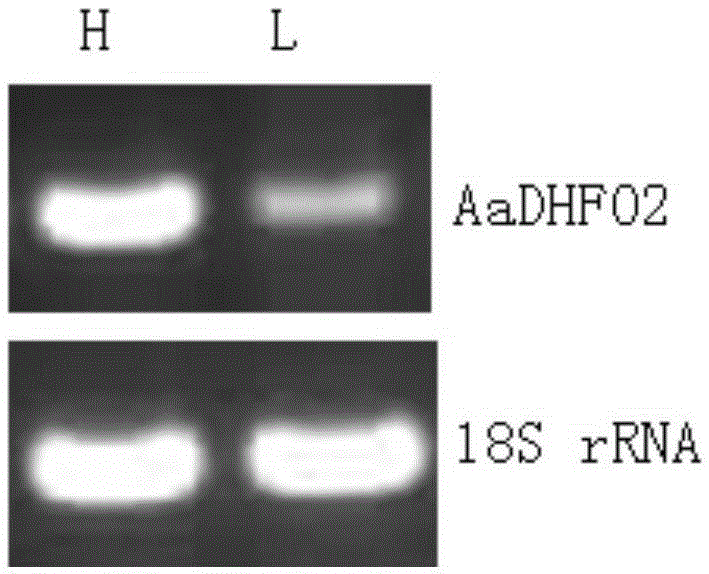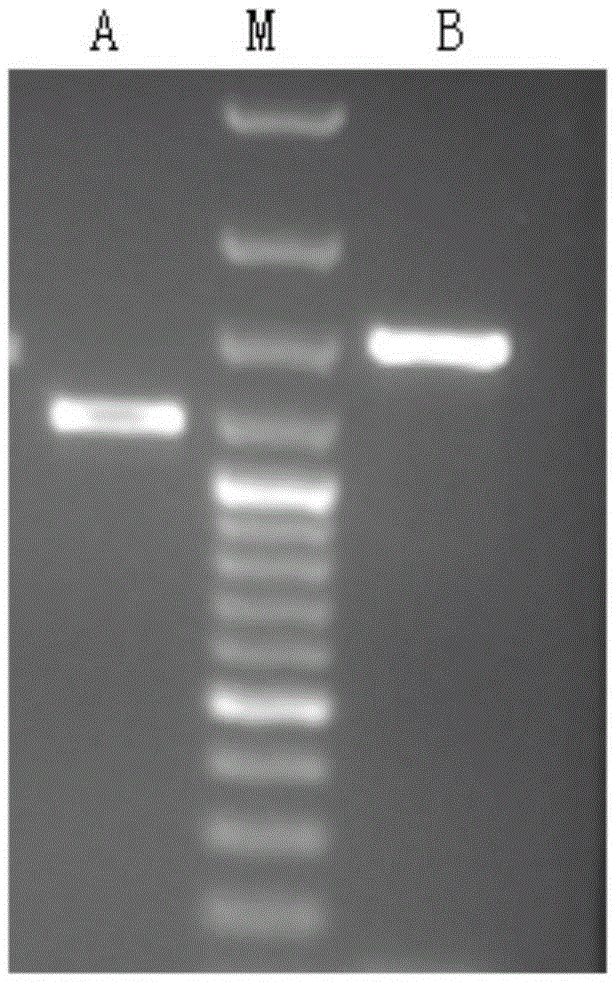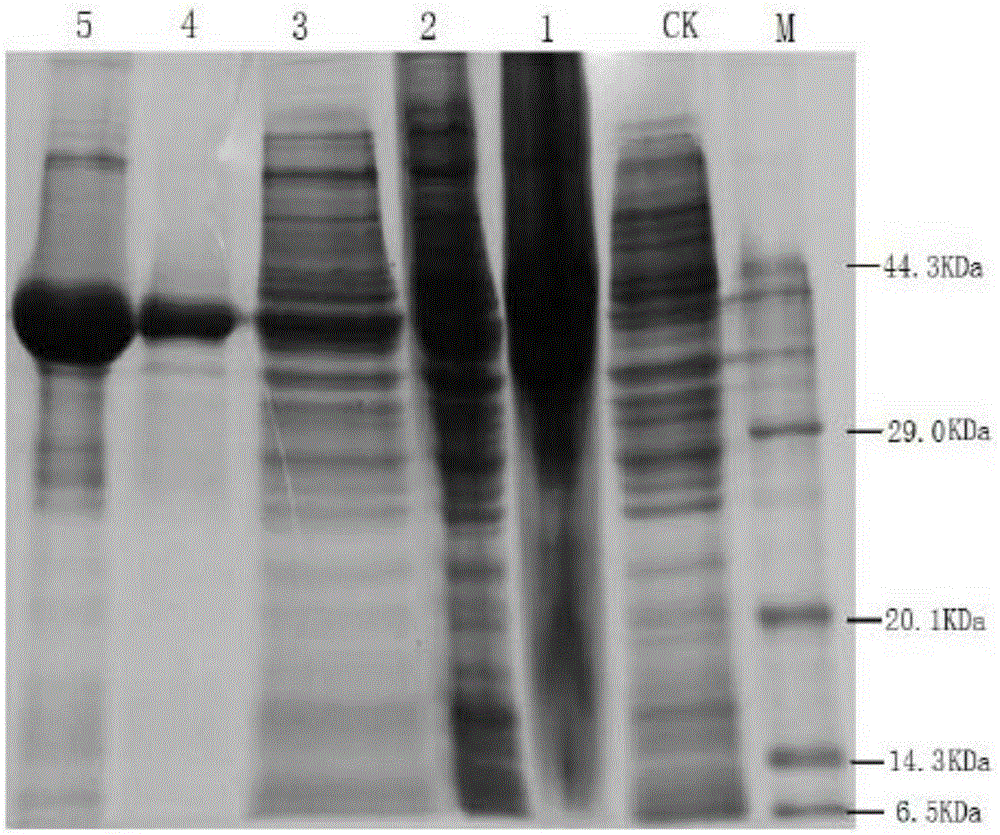Artemisia annua flavanonol oxidase gene AaDHFO2 as well as encoding protein and application thereof
A dihydroflavone and alcohol oxidase technology, applied in the field of genetic engineering, can solve problems such as unclear regulation mechanism, and achieve the effect of reducing costs
- Summary
- Abstract
- Description
- Claims
- Application Information
AI Technical Summary
Problems solved by technology
Method used
Image
Examples
Embodiment 1
[0028] The acquisition of embodiment 1AaDHFO2 gene fragment
[0029] Total RNA was extracted from young leaves of Artemisia annua (HJ2013020) and Artemisia meridiana (NJ201007), respectively, and the DNA in the total RNA was digested with Qiagen’s FreeDNaseSet kit to prevent genomic DNA contamination. Take 0.5 μL of the RNA sample digested with DNA, and use a ThermoScientific company Nanodrop2000c spectrophotometer to measure the sample RNA concentration and OD260 / OD280 value. 1 μL of RNA was taken and detected by 1% Agarosegel electrophoresis to determine the integrity and purity of the RNA sample. Dilute the RNA whose integrity and purity meet the requirements to 200ng / μL for use. Take about 2 μL (2 μg) poly(A) RNA of Artemisia annua and Artemisia annua, add 1 μL of cDNAsythesisPrimer (10 mmol / L) to each, add sterile water to a total volume of 5 μL, mix well, centrifuge briefly, and perform PCR Incubate at 70°C for 2 minutes, cool on ice for 2 minutes, and centrifuge brief...
Embodiment 2
[0030] Cloning of embodiment 2AaDHFO2 gene full-length cDNA sequence
[0031] 5'-RACE primer (DHFO5) was designed according to the sequence of the obtained conserved region fragment: 5'-AGCTCAGGGCATGGACATGGTGGGTAGT-3' (SEQ ID No.3); 3'-RACE primer (DHFO3): 5'-TTGGGTTGTTGTCAAAAAGGTCTTGGACTG-3' (SEQ ID No. 4). The products of primers DHFO5 and UPM have a bright band around 1160bp (see figure 2 ), and the products of primers DHFO3 and UPM have a bright band around 1300bp (see figure 2 ). The PCR products were recovered, ligated and transformed, and among the obtained large number of clones, positive clones were selected for sequencing. By sequencing and splicing in the conserved region sequence, removing the overlapping part, the full-length deoxyribonucleotide sequence was 1978bp, and the analysis showed that the sequence contained a complete coding region of 1008bp, 5'untranslated region (UTR) of 547bp, 3' The untranslated region is 388bp and the polyA tail is 35bp, encod...
Embodiment 3 2
[0033] Example 3 Heterologous expression of dihydroflavonol oxidase gene AaDHFO2
[0034] 1. Construction of recombinant expression vector carrying Artemisia annua dihydroflavonol oxidase gene AaDHFO2
[0035] Using Artemisia annua cDNA as a template, primers were designed according to the sequence SEQIDNo.1, and the deoxyribonucleotide sequence of the coding region of the dihydroflavonol oxidase gene of Artemisia annua was amplified by PCR. EcoRI and XhoI restriction sites were introduced at both ends of the primers respectively, and the primer sequences are as follows:
[0036] Upstream: 5'-CCGGAATTCATGGAGGTGGAAAGAGTTCAAGA-3' (SEQ ID No.5), introducing an EcoRI restriction site, downstream: 5'-CCGCTCGAGTCACTGTGGAAGCTTATTTAGCTTG-3' (SEQ ID No.6), introducing an XhoI restriction site;
[0037] Perform agarose gel electrophoresis on the PCR amplification product, cut out the target band, purify and recover, connect the recovered DNA fragment to the pGEM-Teasy vector, transform...
PUM
| Property | Measurement | Unit |
|---|---|---|
| Molecular weight | aaaaa | aaaaa |
Abstract
Description
Claims
Application Information
 Login to View More
Login to View More - R&D
- Intellectual Property
- Life Sciences
- Materials
- Tech Scout
- Unparalleled Data Quality
- Higher Quality Content
- 60% Fewer Hallucinations
Browse by: Latest US Patents, China's latest patents, Technical Efficacy Thesaurus, Application Domain, Technology Topic, Popular Technical Reports.
© 2025 PatSnap. All rights reserved.Legal|Privacy policy|Modern Slavery Act Transparency Statement|Sitemap|About US| Contact US: help@patsnap.com



